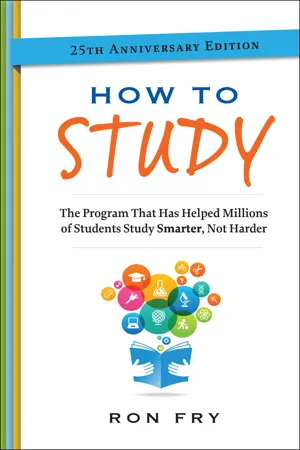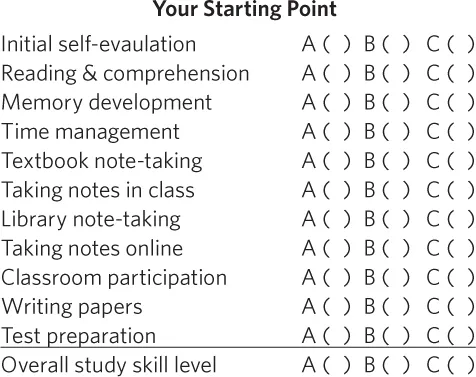
eBook - ePub
How to Study
The Program That Has Helped Millions of Students Study Smarter, Not Harder
- 256 pages
- English
- ePUB (mobile friendly)
- Available on iOS & Android
eBook - ePub
About this book
The bestselling guide that has helped millions of students study smarter, not harder—updated for today's classroom. How to Study reveals the study skills all students need to know to be successful, whether the goal is landing a top scholarship, excelling in school, or preparing to return to school. This edition includes information on how to create an effective work environment, stand out in class, conduct research online, and much more. Fry also covers all the traditional elements of a winning study strategy, such as reading, writing, time management, memory, and test-taking skills. How to Study introduces a revolutionary study system along with examples that give students the edge in any learning environment. How to Study also:
- Prepares students of all ages to excel in their classes by developing effective study skills
- Shows students, in a quick, easy-to-read style, the essential skills that can be applied outside the classroom and later in life
- Includes study tips for teaching and studying with young children; advice for fighting mid-study fatigue and boredom; tips for in-class learning; and more
Frequently asked questions
Yes, you can cancel anytime from the Subscription tab in your account settings on the Perlego website. Your subscription will stay active until the end of your current billing period. Learn how to cancel your subscription.
At the moment all of our mobile-responsive ePub books are available to download via the app. Most of our PDFs are also available to download and we're working on making the final remaining ones downloadable now. Learn more here.
Perlego offers two plans: Essential and Complete
- Essential is ideal for learners and professionals who enjoy exploring a wide range of subjects. Access the Essential Library with 800,000+ trusted titles and best-sellers across business, personal growth, and the humanities. Includes unlimited reading time and Standard Read Aloud voice.
- Complete: Perfect for advanced learners and researchers needing full, unrestricted access. Unlock 1.4M+ books across hundreds of subjects, including academic and specialized titles. The Complete Plan also includes advanced features like Premium Read Aloud and Research Assistant.
We are an online textbook subscription service, where you can get access to an entire online library for less than the price of a single book per month. With over 1 million books across 1000+ topics, we’ve got you covered! Learn more here.
Look out for the read-aloud symbol on your next book to see if you can listen to it. The read-aloud tool reads text aloud for you, highlighting the text as it is being read. You can pause it, speed it up and slow it down. Learn more here.
Yes! You can use the Perlego app on both iOS or Android devices to read anytime, anywhere — even offline. Perfect for commutes or when you’re on the go.
Please note we cannot support devices running on iOS 13 and Android 7 or earlier. Learn more about using the app.
Please note we cannot support devices running on iOS 13 and Android 7 or earlier. Learn more about using the app.
Yes, you can access How to Study by Ron Fry in PDF and/or ePUB format, as well as other popular books in Study Aids & Business Skills. We have over one million books available in our catalogue for you to explore.
Information
Topic
Study AidsSubtopic
Business SkillsChapter 1
Start off Right
“Learn what you are and be such.”
—PINDAR
In the next two chapters, I’m going to help you:



How to keep score
In the next few pages, I’ll explain the primary study skills covered in this book: reading and comprehension; memory development; time management; note-taking (in your textbooks, in class, in the library, while online); classroom participation; researching and writing papers; and test preparation. Then I’ll ask you to rate yourself on your current level of achievement and understanding of each: “A” (excellent) for mastery or near mastery of a particular skill; “B” (good) for some mastery; C (fair to poor) for little or no mastery.
But let’s do a general test first, just to give you a taste of what’s to come. Read the following 28 statements and consider which apply to you. If a statement does apply, mark “Y” (for yes). If not, mark “N” (for no):
1. ____Y ____ N I wish I could read faster.
2. ____Y ____ N I go to class, but I don’t pay a lot of attention.
3. ____Y ____ N I rarely review for tests, but I do spend hours cramming the night before.
4. ____Y ____ N I think I spend more time studying than I need to.
5. ____Y ____ N I usually study with the TV on and constantly check my cellphone.
6. ____Y ____ N I rarely finish all my homework on time.
7. ____Y ____ N I usually write assigned papers the week (or the night) before they’re due.
8. ____Y ____ N I read every book at the same speed and in the same way.
9. ____Y ____ N I can never seem to find the information I need on the Internet.
10. ____Y ____ N I’m overwhelmed with too much homework.
11. ____Y ____ N I can never complete my reading assignments on time.
12. ____Y ____ N I always seem to write down the wrong stuff in class.
13. ____Y ____ N I frequently forget important assignments and test dates.
14. ____Y ____ N I get nervous before exams and do worse than I think I should.
15. ____Y ____ N I frequently must reread whole passages two or three times before I understand them.
16. ____Y ____ N When I finish reading a chapter, I usually don’t remember much of it.
17. ____Y ____ N I try to take down everything the teacher says but usually can’t understand any of my notes.
18. ____Y ____ N I can only study for about 15 minutes before I get bored or distracted.
19. ____Y ____ N When I’m working on a paper or report, I spend most of the time with a thesaurus in my lap.
20. ____Y ____ N I always seem to study the wrong stuff.
21. ____Y ____ N I don’t use any kind of calendar.
22. ____Y ____ N I study for some tests, but I always forget what I studied when I get there.
23. ____Y ____ N I don’t have enough time to do well in school and still have a social life.
24. ____Y ____ N I can’t figure out the important points in my textbooks.
25. ____Y ____ N When I look at my class notes right before a test, I can’t understand them.
26. ____Y ____ N I hate to read.
27. ____Y ____ N I get marked down on essay tests because I don’t organize them well.
28. ____Y ____ N I spend a lot of time on my computer but it feels like most of it is wasted.
What do your answers mean? If you answered “yes” to questions:







It’s not as important how many “yes” answers you had as it is how many were grouped in a specific area—the one in which you obviously need help. (Though 10 or more “yes” answers would indicate problems in more than a single area.)
Let’s go into a little more detail and get an even firmer handle on the current state of your study skills. I’ve listed the primary study skills below. Take a separate piece of paper and rate yourself on each of them (from reading and comprehension through test preparation) before you read the rest of this chapter. Then give yourself two points for every A, one point for every B, and zero points for every C.
If your overall rating is 17 or more, give yourself an A on the “Initial self-evaluation” line; 13 to 16, give yourself a B; and if 12 or less, give yourself a C. This is your assessment of your study habits as they exist right now.
Now, let’s review each of these areas and get a better understanding of what “excellent,” “good,” and “fair” really mean. As you read each section, fill in your rating on the “Your Starting Point” chart—and be honest with yourself. This evaluation will give you a benchmark from which to measure your improvement after you’ve finished How to Study. File it away and make the comparison when you’ve completed reading.
Remember: There are no right or wrong answers in either of these assessments. They are jumping-off points from which you can measure your progress and identify those areas in which your skills need improvement.

Reading and comprehension
Speed, comprehension, and recall are the three important components of reading. Comprehension and recall are especially interrelated—better to sacrifice some speed to increase these two factors. To test your reading and comprehension skills, read the passage below (excerpted from U.S. History: From Reconstruction Through the Dawn of the 21st Century by Ron Olson). Then close the book, jot down the key points made in the selection you read, review the text, and compare your notes with the reading selection. You will get a good idea of how well you understood what you read and just how good your “top-of-the-mind” recall is.
World War I left many Americans disillusioned about war, and the United States retreated into isolationism. Britain and France began to acquiesce to the demands of a new aggressor: Adolph Hitler. Indifference about the changing nation-states in Europe and appeasement of aggressors had ultimately led to global violence. By the late 1930s, 70 percent of Americans felt that the role the country had played in World War I was a mistake.
The United States passed Neutrality Acts allowing it to deny the sale or shipment of munitions to warring nations, opting instead for a cash-and-carry policy. The country needed the income, but it was unwilling to commit to another war. The rumblings of conflict frightened many as totalitarian leaders across the globe flexed their muscles. These leaders posed a threat to security, and the United States couldn’t ignore the possibility of involvement in yet another global conflict. The deaths of 50 million people, along with the horrors and destruction of war, provided a stark conclusion to the conflict of World War II. The devastating loss of population and property in Europe and Japan, the Holocaust that killed six million Jews, the development and use of the atomic bomb, the Soviet domination of Eastern Europe, a divided Germany, Japanese internment camps, and the founding of the United Nations made this war far different from any other in history.
Isolationism was no longer possible. In the United States, World War II highlighted racial inequalities, gave women new opportunities, and fostered growth in the South and West. By devastating the nation’s commercial rivals, World War II left the United States dominant in the world economy. It also increased the scope of the federal government and built an alliance among the armed forces, big business, and science that helped shape post-war America.
Score: If you can read the material straight through, accurately summarize what you’ve read, ...
Table of contents
- Cover Page
- Title Page
- CONTENTS
- Introduction Study to Succeed
- Chapter 1 Start off Right
- Chapter 2 Develop your Plan
- Chapter 3 Read with Purpose
- Chapter 4 Maximize your Memory
- Chapter 5 Manage your Time
- Chapter 6 Excel in Class
- Chapter 7 Ready your Research
- Chapter 8 Write great papers
- Chapter 9 Ace any Test
- Epilogue Celebrate your Success
- INDEX
- Copyright Page